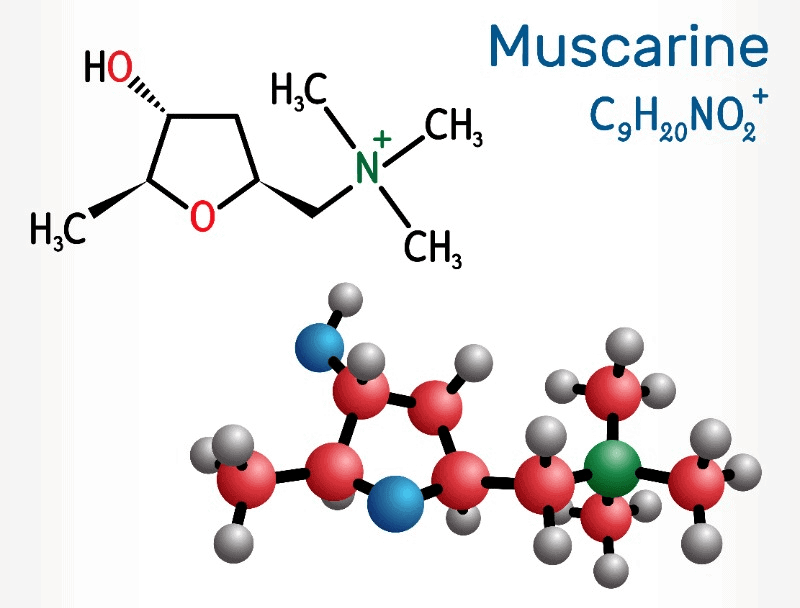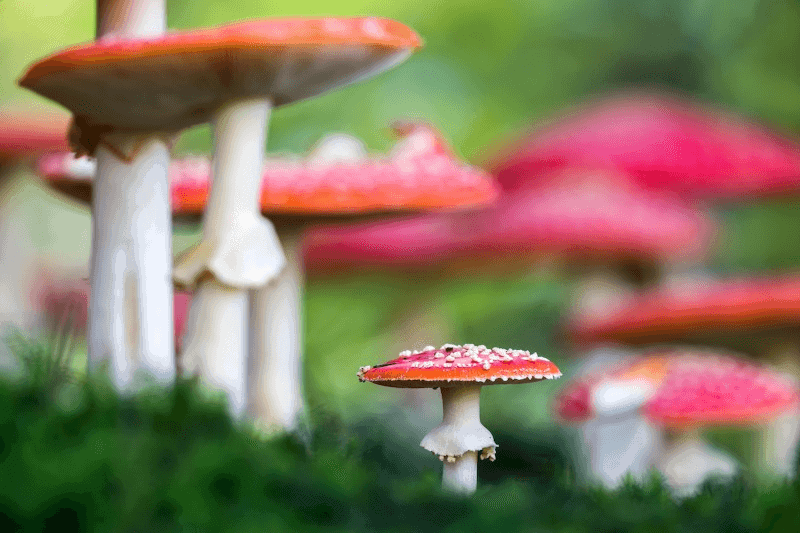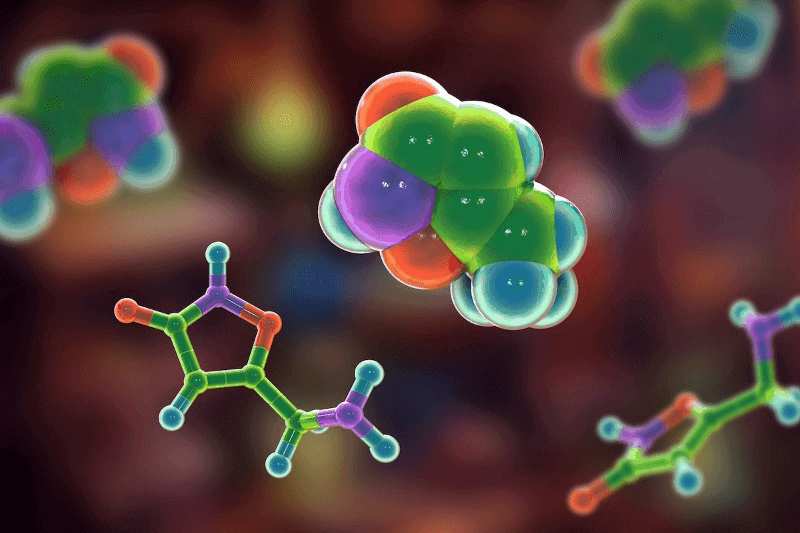Table of Contents
Ever wondered why some mushrooms are off-limits?
It’s all about muscarine, a natural compound that mimics the neurotransmitter acetylcholine, packs a punch on the human body’s smooth muscle, and contrasts with antimuscarinic and nicotine effects. This little molecule, with its hallucinogenic properties and activity akin to nicotine, can turn a forest stroll into an unexpected adventure—or misadventure due to mushroom poisoning—thanks to its potent effects. From making your heart race like you’ve just sprinted for the bus, to turning your vision blurrier than a fogged-up window, muscarine is nature’s way of reminding us that size isn’t everything. In this dive into muscarine and nicotine effects on smooth muscle and mAChRs, we’ll unpack how something so small can have such big impacts on our bodies and minds, affecting patients. Stick around as we explore the wild world of muscarine, machrs, nicotine, and why it deserves our respect—and caution in various species, especially regarding smooth muscle.
Key Takeaways
- Muscarine, a toxin found in certain mushrooms, has significant effects on the body, primarily acting on the parasympathetic nervous system, which can lead to symptoms like sweating, salivation, and blurred vision.
- Understanding its mechanism of action is crucial for medical professionals and researchers, as it targets muscarinic acetylcholine receptors, influencing various bodily functions.
- Though potentially dangerous, muscarine has applications in medical treatments, particularly in research related to diseases affecting the nervous system and eye treatments.
- Awareness and knowledge of muscarine poisoning symptoms are essential for timely diagnosis and treatment, highlighting the importance of toxicology in clinical settings.
- The impact of muscarine on behavioral and nervous system functions offers insights into neurotransmitter activities, providing a basis for studying neurological disorders.
- Case studies and comparative analyses enrich our understanding of muscarine’s effects and therapeutic potential, underscoring the value of ongoing research in this area.
Understanding Muscarine

Chemical Nature
Muscarine is a natural alkaloid. It’s found in some mushroom species and has a structure similar to acetylcholine, an important neurotransmitter in our bodies that affects smooth muscle; this substance is muscarin, not to be confused with nicotine. This similarity, involving machrs in smooth muscle, is key to understanding how muscarine and nicotine affect us, including their adverse effects.
Mushrooms that contain muscarine can be both fascinating and dangerous. Not all of them are toxic, but identifying safe ones requires expert knowledge. This highlights the importance of being cautious when foraging or consuming wild mushrooms.
Sources of Muscarine
Mushrooms

The mushroom Amanita muscaria is well-known for containing muscarine. However, not all mushrooms with this compound are harmful to humans. The skill in distinguishing between safe and toxic varieties lies with seasoned mycologists.
It’s interesting to note that while many fear the dangers of these fungi, certain species have been used traditionally by various cultures for their psychoactive effects.
Plants
Some plants also produce substances similar to muscarine and nicotine, though they’re much rarer than their fungal counterparts. These plant-based sources haven’t been studied as extensively but pose an intriguing area of research regarding their impact on natural predators and potential medicinal uses.
The rarity of these plants adds another layer of mystery to the study of natural toxins and their roles in ecosystems.
Aquatic Animals
Aquatic species can bioaccumulate muscarine, which sometimes leads to its presence in shellfish consumed by humans. This bioaccumulation poses a risk not just directly from eating the contaminated shellfish but also raises concerns about longer-term impacts on marine food chains.
Understanding how these animals come into contact with muscarine—and what it means for both them and us—is crucial for ensuring food safety.
Structure and Reactivity
Muscarine’s quaternary ammonium structure makes it stable under normal conditions yet reactive towards strong acids or bases. Its hydrophilic nature influences how it interacts biologically within organisms.
This stability means that once inside the body, muscarine can effectively mimic acetylcholine without breaking down quickly—leading to prolonged effects on nerve cells until properly metabolized or excreted.
Mechanism of Action

Muscarinic ACh Receptors
Muscarine targets muscarinic acetylcholine receptors (mAChRs). These receptors play a crucial role in the body’s response to muscarine. There are five subtypes, each with its own function within various parts of the body. They primarily affect the parasympathetic nervous system, which is responsible for rest and digest activities.
The interaction between muscarine and these receptors demonstrates a high affinity binding. This means muscarine can effectively influence bodily functions by activating or inhibiting these receptors. The effects vary depending on which subtype of mAChR is involved. For instance, some subtypes might slow down the heart rate, while others could stimulate secretions in the digestive system.
Each receptor subtype also has a unique way of signaling within cells through protein coupling mechanisms. This diversity in function and signaling pathways allows muscarine to have widespread effects throughout the body.
Autonomic Nervous System
Muscarine doesn’t just stop at affecting one part of the nervous system; it influences both branches – sympathetic and parasympathetic. Normally, these systems work together to maintain balance in bodily functions like heart rate and digestion.
However, when muscarine comes into play, this balance can be disrupted due to its strong effect on parasympathetic sites compared to sympathetic ones. This disruption can lead to symptoms such as excessive salivation or slowed heart rate because the parasympathetic actions overpower those of the sympathetic nervous system.
The impact on both systems explains why muscarine poisoning leads to a wide range of symptoms that reflect an overactive parasympathetic nervous system alongside an underactive sympathetic response.
- Pros:
- Can help understand certain medical conditions related to neurotransmitter imbalances.
- Offers insights into how drugs targeting mAChRs could be developed for therapeutic purposes.
- Cons:
- Disruption between autonomic branches can cause severe health issues if not managed properly.
- Understanding individual responses requires complex medical knowledge about each mAChR subtype.
Muscarine Effects on the Body
Cholinergic Toxidrome
Muscarine, when introduced into the body, can lead to a condition known as cholinergic toxidrome. This condition is marked by excessive salivation, tears (lacrimation), frequent urination, and defecation. Patients might also experience intense gastrointestinal distress and vomiting. These symptoms are collectively remembered by the acronym SLUDGE.
Cholinergic toxidrome results from the overactivation of cholinergic pathways in the body. It’s crucial to understand this effect follows directly from muscarine’s interaction with neurotransmitter systems discussed earlier. Unlike other reactions caused by substances like anticholinergics or sympathomimetics, cholinergic toxidrome creates a unique set of challenges for medical professionals due to its distinct symptom profile.
Muscarinic Toxicity
Symptoms
Individuals exposed to muscarine may initially notice blurred vision and excessive sweating. A rapid heartbeat often accompanies these early signs. As exposure levels increase or sensitivity plays a role, more severe symptoms can emerge such as difficulty breathing and convulsions.
The severity of muscarinic toxicity varies greatly among individuals. Factors include the dose received and one’s personal sensitivity to muscarine.
Treatment
Immediate treatment for those suffering from muscarinic toxicity involves administering atropine. Atropine serves as an antidote because it blocks muscarine’s effects on receptors throughout the body.
Supportive care focuses on managing respiratory and cardiovascular symptoms that arise due to overstimulation of acetylcholine receptors. Decontamination procedures play a critical role if initiated early after exposure.
Muscarine in Medical Treatments
Muscarinic Agonists
Muscarinic agonists work by mimicking the effects of muscarine on muscarinic acetylcholine receptors (mAChRs). These substances are useful in treating conditions like dry mouth and glaucoma. They stimulate glands to produce saliva or increase fluid drainage from the eye, respectively.
However, their use requires precision. Too much can lead to toxicity. Symptoms might include excessive sweating or blurred vision. That’s why doctors carefully adjust doses for each patient.
Muscarinic Antagonists
On the flip side, muscarinic antagonists block the action of muscarine at its receptor sites. A famous example is atropine, often used during surgery to keep the heart rate stable or as an antidote for certain poisonings.
Like agonists, these drugs come with a risk of side effects if overdosed. Patients might experience dry mouth, difficulty urinating, or even hallucinations. It shows how crucial proper dosing is.
Cholinergic Drugs
Cholinergic drugs encompass both muscarinic agonists and antagonists like atropine and muscarine itself. Their uses are diverse, ranging from facilitating eye surgeries by dilating pupils to treating bradycardia—a condition where the heart beats too slowly.
The key takeaway here is that dosing is critical with cholinergic drugs to avoid adverse effects while achieving therapeutic benefits.
Poisoning and Toxicology
Mushroom Toxins
Muscarine is a potent toxin found in certain mushrooms. It’s not alone, though. Mushrooms can also contain amatoxins and psilocybin, each with unique effects on the human body. Knowing which toxin has been ingested is vital for effective treatment.
Different toxins require different approaches. For example, while muscarine affects the parasympathetic nervous system, amatoxins target the liver and kidneys, and psilocybin impacts the brain, altering perception and mood. This diversity underscores the importance of accurate identification in cases of mushroom poisoning.
Toxicity Mechanism
Muscarine works by binding irreversibly to muscarinic acetylcholine receptors (mAChRs). This action prolongs their activation far beyond normal levels. As a result, it leads to an overstimulation of parasympathetic nervous system functions like salivation, tear production, urination, digestion, and heart rate reduction.
This mechanism is distinct from that of neurotoxins which directly interfere with neuronal transmission across synapses. The specificity of muscarine’s action makes its effects particularly dangerous but also allows for targeted antidote strategies.
Antidote for Poisoning
When dealing with muscarine poisoning,time is critical . The sooner treatment begins; the better the outcome tends to be. Antidotes work by targeting muscarinic receptors to block further action of muscarine on these sites. In severe cases involving cardiovascular symptoms,epinephrine may be administered alongside atropine to counteract these effects effectively. However,the efficacy of treatment decreases as more time passes post-exposure, emphasizing early intervention’s importance.
Behavioral and Nervous System Impact
Neurotransmitter Receptors
Muscarine targets specific receptors in the brain known as muscarinic acetylcholine receptors (mAChRs). These are a type of G protein-coupled receptor. They play a big role in how our nervous system works. Muscarine’s ability to affect these receptors explains why it has such strong effects.
The body has different types of mAChR subtypes. Each one does something different. This variety means scientists could make new medicines that only target certain problems without causing side effects elsewhere.
Nervous System Toxicology
When someone gets poisoned by muscarine, it mainly hits the peripheral nervous system first. But if there’s enough poison, it can also affect the brain and other central parts. This is serious because high doses can do long-term damage.
Most research on muscarine focuses on what happens right after poisoning occurs. We don’t know much about what might happen if you’re exposed to it over and over again.
Dealing with this kind of poisoning mostly involves treating symptoms quickly to prevent worse problems later on.
How well someone recovers from muscarinic poisoning depends a lot on how severe their case was to start with.
Muscarine in Research
Bioactive Alkaloids
Alkaloids are fascinating molecules. They interact with our bodies in complex ways. Beyond muscarine, there’s a whole world of these compounds. Take nicotine, for example. It also targets acetylcholine receptors. Yet, it behaves differently from muscarine.
Muscarine and nicotine show us the diversity of plant-animal interactions. This variety is crucial in toxicology studies. It helps scientists understand how different substances affect living organisms.
Chemical Classes of Alkaloids
Alkaloids come in various shapes and forms based on their core structure. Muscarine falls into the quaternary ammonium class due to its chemical nature.
This class alone has a wide range of effects on our pharmacological landscape. By studying these classes, researchers can uncover new insights into toxicity mechanisms and potential treatments.
Case Studies and Reports
Family Members Poisoning
Reports often highlight tragic cases where entire families suffer due to poisonous mushrooms. These incidents usually happen because of shared meals. A single contaminated dish can affect everyone at the table. It’s a stark reminder of nature’s hidden dangers.
Education is our best defense against such group poisonings. Knowing which mushrooms are safe and which aren’t can save lives. Communities should promote awareness about the risks of foraging without proper knowledge.
Quick action is key when poisoning occurs. Recognizing symptoms early helps reduce their impact on all affected family members. This collective approach differs from treating individuals alone.
Medical Uses of Muscarine
Muscarine has limited medical applications today, mostly because there are safer drugs available. Its narrow therapeutic window makes it less favorable compared to other treatments.
However, muscarine played a crucial role in past research on the autonomic nervous system (ANS). Scientists used it to understand how ANS functions, laying groundwork for future discoveries.
There’s ongoing interest in muscarine for targeting specific receptor subtypes in therapy development. This could lead to new treatments that are more effective with fewer side effects.
Comparison and Analysis
Effects on CA1 Field Potentials
Muscarine, a well-known agent in neuroscience research, plays a unique role in the modulation of hippocampal neuron activity. Unlike other substances that might have broader effects across the nervous system, muscarine’s action through muscarinic acetylcholine receptors (mAChR) is distinct. This specificity allows for precise alterations in how neurons communicate within the hippocampus.
The impact of this modulation is particularly significant when considering learning and memory processes. By altering synaptic plasticity—the ability of synapses to strengthen or weaken over time—muscarine offers insights into how our brains form new memories or learn new information. Studies focusing on the CA1 field potentials provide evidence that muscarine can enhance or inhibit these processes under different conditions.
This area of study opens up avenues beyond traditional discussions around neurotransmitter receptors or bioactive alkaloids. It shifts the focus towards understanding cognitive functions at a more granular level, offering valuable perspectives on how disruptions in cholinergic systems affect cognition without delving into general toxicology or medical applications.
- Muscarine affects learning by changing synaptic strength.
- Its action through mAChR provides unique insights into cognitive function.
Research findings underscore the importance of cholinergic signaling pathways in maintaining cognitive health and highlight potential areas for therapeutic intervention targeting memory disorders. The specificity with which muscarine acts also suggests possible strategies for mitigating adverse effects related to cholinergic system disruptions without overlapping significantly with broader discussions about neurotransmitters’ roles in toxicity and medicine.
Summary
Diving into the world of muscarine, you’ve journeyed through its intricate dance within the body, from its role in medical treatments to the darker side of poisoning and toxicology. It’s clear that this compound is a double-edged sword, offering both promise and peril. You’ve seen how it tugs at the threads of our nervous system, painting a vivid picture of its impact on behavior and health. Through case studies and comparisons, the complexity of muscarine has been laid bare, inviting you to ponder its place in both nature and medicine.
Now, armed with this knowledge, we encourage you to keep the conversation going. Share your thoughts, experiences, or questions about muscarine with peers or professionals. Whether it sparks an interest in further research or simply satisfies a curious mind, your engagement can shine a light on this fascinating molecule’s role in our world. Let’s keep digging deeper together.
Frequently Asked Questions
What is muscarine and how does it work?
Muscarine is a toxin found in certain mushrooms. It mimics the neurotransmitter acetylcholine, binding to its receptors in the body, which can affect various bodily functions from saliva production to heart rate.
How does muscarine affect the human body?
Muscarine primarily stimulates the parasympathetic nervous system, leading to symptoms such as excessive salivation, sweating, tears, a slow heartbeat, and in severe cases, difficulty breathing.
Can muscarine be used for medical treatments?
Yes! In controlled doses and forms, muscarine or its analogs can help treat diseases like glaucoma by reducing intraocular pressure or stimulate secretions during surgeries.
What are the signs of muscarine poisoning?
Look out for profuse sweating, blurred vision, abdominal pain, nausea. These are classic signals that someone might have been poisoned by muscarine.
How do scientists use muscarine in research?
Researchers use muscarine to study neurobiological processes and diseases because it specifically targets cholinergic systems—those involving acetylcholine—a crucial neurotransmitter in both humans and animals.
Are there any real-world case studies on muscarine poisoning, involving its antimuscarinic and hallucinogenic properties, and its interaction with cholinergic receptors and the neurotransmitter acetylcholine?
Absolutely! There are documented cases where individuals accidentally consumed toxic mushrooms containing high levels of muscarine leading to hospitalization but also providing valuable insights into its effects and treatment protocols.
